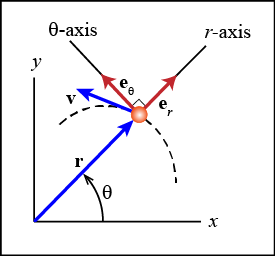Plane Curvilinear Motion - Polar Coordinates
Position
The polar coordinate system is defined by the coordinates r and θ. Just like the n-t coordinate axes, the r and θ axes are attached to and move with the particle.
- Position: (r) The vector that starts at the origin of the x-y coordinate system and points to the particle.
r = rer

Velocity
The r-θ axes are body-fixed. That means that they are attached to and move with the particle. We know that velocity is the time rate of change of position as shown below. As you can see, the velocity equation contains the time derivative of a unit directions vector. The time derivative of a unit direction vector in a body-fixed coordinate system is generally not zero.
v = dr/dt = d(rer )/dt = (dr/dt)er + r(der /dt)
der /dt = (dθ/dt)eθ
deθ /dt = -(dθ/dt)er
Using the values for the time derivative of the unit direction vectors, we get the following polar coordinate velocity equation.
v = (dr/dt)er + r(dθ/dt)eθ
Acceleration
The acceleration is the time rate of change of velocity as shown below. Again, the derivatives of the unit direction vectors are not generally zero.
a = dv/dt = d((dr/dt)er + r(dθ/dt)eθ )/dt
Using the above expressions for the time derivatives of the unit direction vectors, we get the following polar coordinate velocity equation.
a = ((d 2r/dt 2) - r(dθ/dt)2)er + (r(d 2θ/dt 2) + 2(dr/dt)(dθ/dt))eθ
